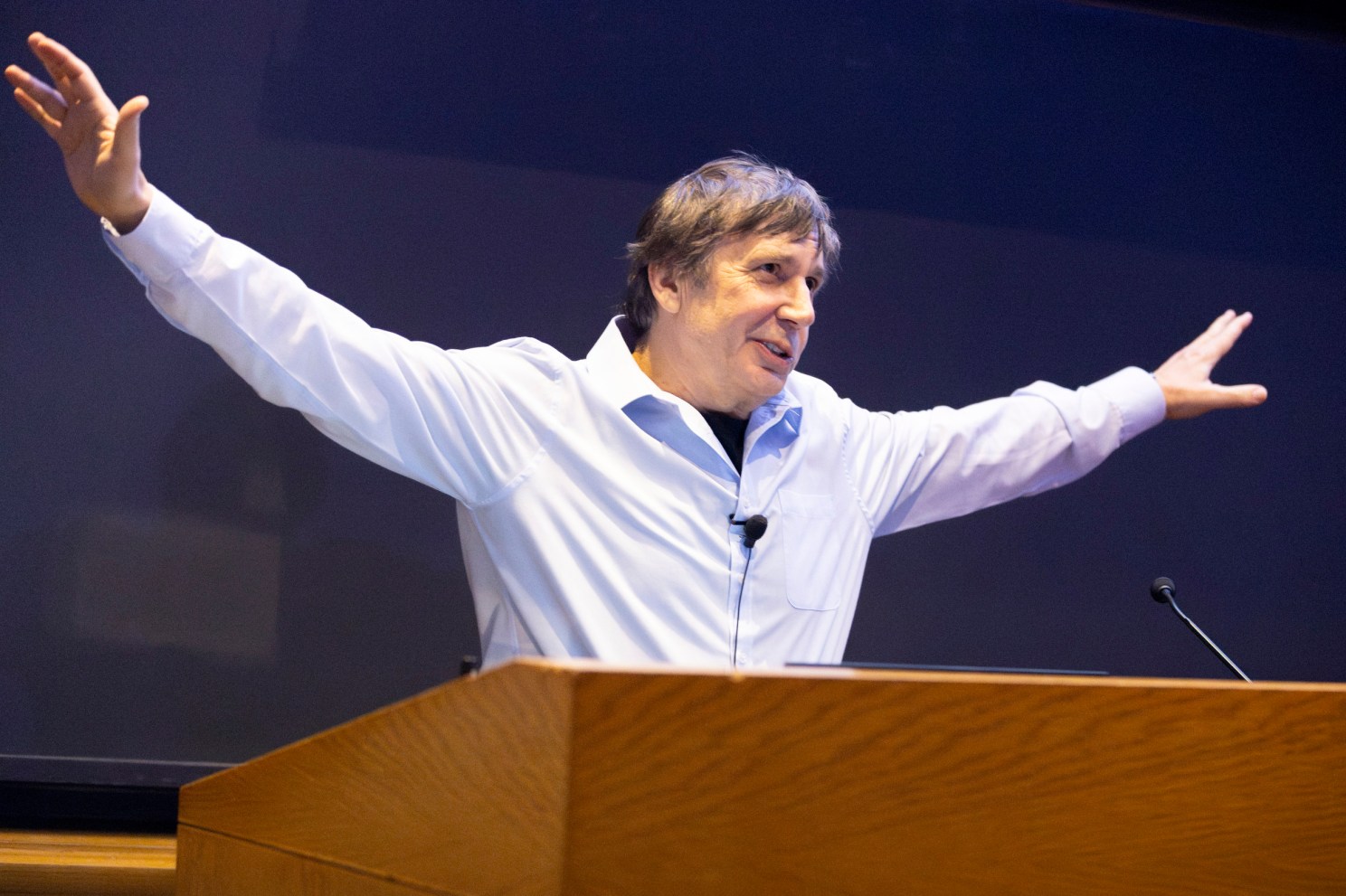
Sir Andre Geim giving the Morris Loeb Lecture.
Niles Singer/Harvard Staff Photographer
How did you get that frog to float?
Ever-creative, Nobel laureate in physics Andre Geim extols fun, fanciful side of very serious science
Sir Andre Geim won the 2010 Nobel Prize in physics for his experiments with graphene, a strong, ultra-thin conductor of electricity and heat that could revolutionize all kinds of technology and gadgets. But one would never guess what he was up to one Friday night a decade prior.
Geim, then a young professor at Radboud University in the Netherlands, found himself in the lab after a few beers, doing an experiment with magnetism. And that was how he came to eventually levitate a live frog, a feat for which he received an Ig Nobel Prize — a tongue-in-cheek, annual international award that recognizes weird science.
The double laureate reflected on his two most celebrated achievements during the light-hearted third installment of the Morris Loeb Lecture Series last week, hosted by the Department of Physics. The lesson? Geim exhorted the audience, filled with aspiring scientists, to not take themselves too seriously.
“Knowledge is a lot of fun,” he said.
The frog experiment (suggested by his wife) was indeed fun, but the process began with hard science later leavened by the kind of the creative thinking for which Geim has come to be known. (His work with graphene began with the discovery that one-atom-thick pieces could be produced by taking a bit of graphite and applying and peeling off ever-thinner flakes with Scotch tape.)
Geim was in the lab that evening because he’d been pondering quantum phenomena that could be explored at room temperature — long an elusive goal for scientists.
“I saw levitating water inside the magnet after a few minutes of experimenting,” recalled the University of Manchester professor. He called them “kissing droplets” for how they moved and morphed around each other, and found watching the movement “therapeutic.”
But he got to thinking: The phenomenon he exploited that day, called diamagnetism, is seen in water, food, and other organic molecules. It occurred to him that he could probably get more objects to levitate. He moved on to strawberries, cherry tomatoes — and his wife’s frog idea.
Thus was born the idea for a paper Geim co-authored with colleague Michael Berry, “Of flying frogs and levitrons,” leading to the scientists’ 2000 Ig Nobel, which for many years was awarded at a ceremony in Sanders Theatre. Geim remains the only person to have won both an Ig Nobel and an actual Nobel, also making him a Guinness World Record holder.
Then came the shock of publicity — “good, bad, and ugly,” Geim told the appreciative audience. “I did enjoy it, to be honest, especially being a young professor,” he said, as he flashed slides of headlines in every language lauding the flying frog. “But some publicity I won’t like to share with you, because it was completely ridiculous.”
The frog, by the way, was unharmed. “We returned it to the biology department,” Geim said.
In the first two installments of the Loeb lectures earlier in the week, Geim lectured on graphene and other one-atom- or one-molecule-thick “wonder materials” and why they have drawn so much attention in the scientific and technology communities. He also explored the work that has been made possible by the creation of ultra-thin 2D spaces.
The flying-frog talk included astonishing videos of levitating objects set to music, an overview of the physical forces that make levitation possible, and a smattering of equations.
Leveraging diamagnetism, which gives all matter a degree of weak magnetism, all one needs to levitate a frog is a magnetic field 1,000 to 10,000 times stronger than a refrigerator magnet, or 10 times stronger than an MRI machine, Geim explained. The response of the atoms in the frog’s body to the 10-tesla magnet is sufficient to balance against gravity, essentially “canceling” the amphibian’s gravitation.
Geim said his dabbling with levitation was well worth the time, trouble, and money spent. After all, it was fun sorting out the physics and finding new collaborators along the way. He closed with a slide showcasing a piece of fan mail from a then-9-year-old budding scientist, requesting more information about “how you got the frog to float.”





